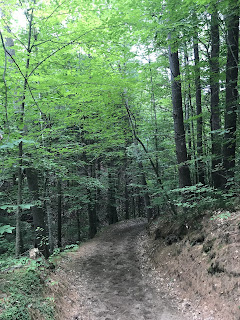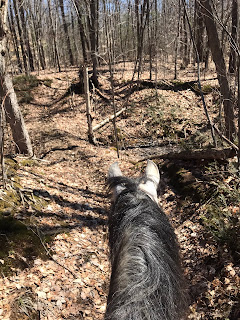Train the Brain
My last horse Jazz passed over the rainbow bridge way too early at the age of 13 but forced me to learn some very important lessons about opinionated horses. Having had pretty easy horses up to that point, including his mom, I did not understand, appreciate or even see the warning signs until one summer day at the overcrowded warm-up ring of a local horse show, he proceeded to back me up out of the arena with a complete loss of the forward button. He was 5 at the time, and just at the age where temper tantrums can begin.
When I called up my coach to restart lessons, I remember describing the situation as “no big deal”. Boy was I wrong.
That was when my high school (and his) began.
My coach would need to repeat the same mantra many times, and over many years, before it finally stuck. "Train the Brain."
Four years later I ended up with a toolbox of gymnastics and patterns that work the mind. It is also when I made the transition to trail classes and equitation patterns in both western and english disciplines that really forced a level of precision, discipline and control I had never before achieved.
Lately the internet has been ablaze with the one-pole challenge. For those of you working with opinionated horses, I suggest the three cone challenge. Set the cones up in a straight line, thirty feet apart. If you have a smaller place, twenty feet apart. Use each cone as a marker of a transition that you execute when the horse shoulder lines up.
Pick three of the following in whichever order you want, and set it in your mind as the pattern and transition for each cone. Do the pattern ten times until perfect and each transition is soft. Congratulate yourself for a job well done and tackle it again the next day with a new set of three transitions. Do this 7 days in a row.
Easy Transitions:
- Walk (collected or extended)
- Jog or Trot (collected or extended)
- Lope or Canter (left lead, right lead, collected or extended)
- Halt
- Back-Up
- Turn (on the haunches or the forehand, 90/180/360 degrees)
- Simple Lead Change
- Shoulder-in at the walk, trot or canter
- Haunches-in at the walk, trot or canter
- Flying Lead Change
- Spin
All of this can be done inside a 30 minute riding session, with 5 minutes for warm-up and cool down. Don't worry about headset and quality of gait just yet.
1. An example of a starter pattern performed on a straight line:
- Halt at cone 1 (lined up with horse shoulder). Nod to the imaginary judge.
- Sitting trot to cone 2.
- Canter right lead in a circle and return to cone 2.
- Halt at cone 2.
- Sitting trot to cone 3.
- Halt at cone 3.
- Back up four steps. Halt. Nod to the imaginary judge.
2. An example of an intermediate pattern performed on a straight line:
- Halt at cone 1 (lined up with horse shoulder). Nod to the imaginary judge.
- Canter left lead to cone 2.
- Halt at cone 2.
- Canter right lead to cone 3.
- Halt at cone 3.
- Back up four steps. Halt. Nod to the imaginary judge.
Things to watch for: straightness, immediate and obedient transitions at the cone, precision of transition from halt to trot or canter to halt without walking (or trotting). Eventually you can work in quality of gait and smooth transitions.
For more ideas, pick a pattern from one of these: https://www.showhorsepromotions.com/equitation.htm
I now believe that a good ride = hundreds of transitions. I watch many riders in the arena working on the rail at a trot or canter and I often wonder what their objective is as they circle around me for 20-30 minutes. Because while you might achieve cardio objectives for the horse ... a fit horse that has a lazy brain is a dangerous thing indeed.
Train the brain.






Comments
Post a Comment